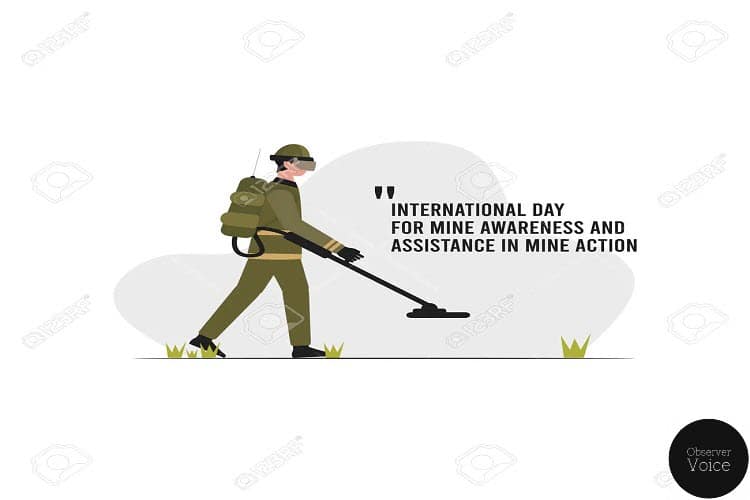International Day for Mine Awareness: History, Theme, and Significance

International Day for Mine Awareness is a global observance day that aims to raise awareness about the dangers of landmines and explosive remnants of war (ERW). It is observed every year on April 4th to remind the international community of the importance of mine action and to promote efforts to eradicate landmines and ERW around the world.
Landmines and ERW are remnants of armed conflicts and wars that continue to pose a significant threat to civilian populations. These deadly devices do not differentiate between combatants and non-combatants, and their victims are often innocent civilians, including children, women, and the elderly.
International Day for Mine Awareness 2024: Theme
The theme for International Day for Mine Awareness & Assistance in Mine Action 2024 is ‘Protecting Lives, Building Peace. On the occasion of the International Day of Mine Awareness 2023, the theme is “Safe Ground, Safe Steps, Safe Home ”.
International Day for Mine Awareness: History
The General Assembly declared 4 April of each year the International Day for Mine Awareness and Assistance in Mine Action on 8 December 2005. In 2006, it was observed for the first time.
In some parts of the world, landmines and explosive remnants of war have been eradicated. 164 countries have ratified the 1997 Mine Ban Treaty, which prohibits the use, stockpiling, production, and transfer of antipersonnel mines, and 120 countries have ratified the Cluster Munitions Convention, which bans the use, stockpiling, production, and transfer of cluster munitions.
International Day for Mine Awareness: Significance & Celebration
The International Day for Mine Awareness provides an opportunity for governments, non-governmental organizations, and individuals to come together to raise awareness about the impact of landmines and ERW and to advocate for the implementation of effective mine action programs. These programs include clearing landmines and ERW, destroying stockpiles, and educating communities on the dangers of these devices.
To mark International Day for Mine Awareness, events and activities are organized around the world, including mine risk education campaigns, public events, and fundraising initiatives. These events provide an opportunity to raise awareness about the impact of landmines and ERW, to honor the victims of these devices, and to advocate for the implementation of effective mine action programs.
International Day for Mine Awareness dates and days
The International Day for Mine Awareness and Assistance in Mine Action is observed on April 4 each year. Here are the dates and days for the last 5 years:
- 2024: Thursday, April 4
- 2023: Tuesday, April 4
- 2022: Monday, April 4
- 2021: Sunday, April 4
- 2020: Saturday, April 4
FAQ on International Day for Mine Awareness
1. What is the International Day for Mine Awareness?
The International Day for Mine Awareness and Assistance in Mine Action is observed annually on April 4th. It aims to raise awareness about the dangers of landmines and explosive remnants of war and to promote efforts to eliminate them.
2. Why is the International Day for Mine Awareness important?
Landmines and explosive remnants of war continue to pose a significant threat to civilians in conflict-affected areas long after the cessation of hostilities. This day raises awareness of the devastating impact of mines on individuals, communities, and countries, and highlights the importance of mine action efforts for humanitarian, social, and economic development.
3. What are landmines and explosive remnants of war?
Landmines are explosive devices placed under or on the ground to destroy or disable enemy targets, often designed to explode when triggered by the presence, proximity, or contact of a person. Explosive remnants of war include unexploded ordnance, abandoned explosive ordnance, and other explosive devices that remain after conflicts end.
4. How do landmines and explosive remnants of war affect communities?
Landmines and explosive remnants of war cause death, injury, and disability, particularly among civilians, including children, women, and the elderly. They also hinder post-conflict reconstruction and development efforts by contaminating land, preventing access to essential services, and displacing populations.
5. What is mine action?
Mine action refers to a set of activities aimed at reducing the impact of landmines and explosive remnants of war, including clearance of contaminated areas, risk education to raise awareness, victim assistance to support survivors, advocacy for stronger policies, and capacity building in affected countries.
6. Who is responsible for addressing the issue of landmines and explosive remnants of war?
Addressing the issue of landmines and explosive remnants of war requires collaboration among governments, international organizations, non-governmental organizations, and civil society. States parties to the Anti-Personnel Mine Ban Convention (Ottawa Treaty) have specific obligations to eliminate landmines, while other legal frameworks and treaties also address explosive remnants of war.
7. What can individuals do to support mine action efforts?
Individuals can support mine action efforts by raising awareness about the issue, advocating for stronger policies and funding for mine clearance and victim assistance, supporting organizations working in affected communities, and promoting measures to prevent further use and production of landmines and explosive remnants of war.
Observer Voice is the one stop site for National, International news, Sports, Editor’s Choice, Art/culture contents, Quotes and much more. We also cover historical contents. Historical contents includes World History, Indian History, and what happened today. The website also covers Entertainment across the India and World.
Follow Us on Twitter, Instagram, Facebook, & LinkedIn

